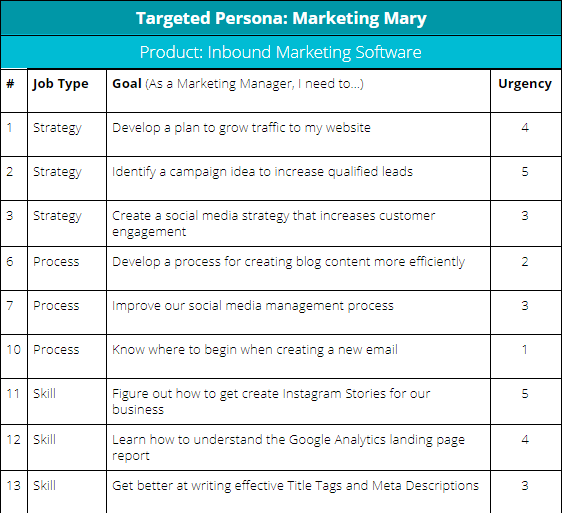
Written By:
Sean Henri
As an inbound marketer, you’ve likely seen a ton of content about the value of pillar pages and a topic-cluster approach to SEO. While there is plenty out there describing the merits of this approach, and what a good pillar page might look like, there wasn’t a very useful resource that walks marketers through the process of actually creating topic clusters and pillar page content from start to finish. Until now.
With this in-depth, tactical guide—chock-full of video lessons, templates, frameworks, and resources—you’ll be creating your very own pillar pages and topic clusters while avoiding the mistakes and pitfalls most marketers make.
Step 1: Understand Pillar Pages and Topic Clusters

We all want to create blog content that causes our websites to climb to the top of search results, driving a surge in website traffic, more qualified leads, and more revenue.
But those marketers who bought into the early promise of inbound marketing—the idea that “if you build it, they will come”—often find themselves disillusioned after one or two years of consistent blogging activity.
A client recently emailed me and said “I’ve been blogging about all of the topics you identified, and I feel like our content is so much better than our competitors. Why aren’t we doing better?”
She was being honest. They had written a blog post for nearly every keyword I helped them identify as a priority, and their content was actually quite good. The problem was that there was a mismatch in the type of content they were creating in response to the terms they were targeting. The content they were creating for broad, two-word terms that were competitive and heavily searched were equal in length, depth, and quality to the content they were creating for long-tail terms that were much more specific and far less competitive.
In other words, they were failing to recognize that search engines now require more depth and breadth in the content they serve for search queries around broad topics than they need and require for more specific, long-tail search terms.
Let’s take a broad topic like “lawn mower repair” as an example.
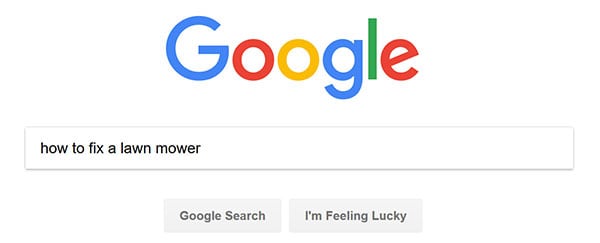
The person conducting this search could have many different goals in mind. For example, they might want to:
- Find a local lawn mower repair service
- Learn how to repair the lawn mower on their own
- Buy the right part necessary to do the repair
- Find a guide that will help them diagnose what needs to be repaired in the first place
A search engine like Google simply doesn’t know what a person’s real intent is when they conduct a search like this, so it needs to take its best shot at guessing based on all available data. They do this by serving up a blend of different kinds of content on the first page of results, hoping that one or two might appeal to the searcher’s intent. We call this a “mixed intent search results page.”
Note: A broad search like this is rarely the final step in the searcher’s journey. In fact, it’s more likely to be the first of many searches that individual will do until they find a satisfactory solution.
Let’s assume the searcher is hoping to do the repair themselves. This means they’d skip the top results that show local businesses, and instead opt to click on a top-ranked article by Popular Mechanics titled “How to Fix a Lawn Mower.”
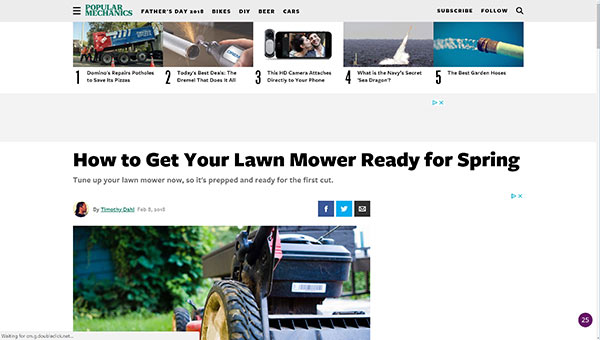
The article, at 625 words in length, provides a high-level overview of basic lawn mower maintenance and preventative measures, but very little guidance on how to fix real problems, like a smoking mower, dead battery, or busted belt.
Frustrated by what some call “thin” content, dissatisfied searchers might find themselves hitting the back button and moving on to the next result with the hope it might help them complete their task. They might also try refining their search to something more specific—for example, “how to fix a smoking lawn mower” or “how to change a lawn mower battery.”
Google sees this behavior—referred to as “pogo-sticking”—so it displays a list of suggested searches in the “People also search” box below the result. In our example, these suggestions include terms like:
- Lawn mower repair videos
- Lawn mower repair parts
- Lawn mower repair costs
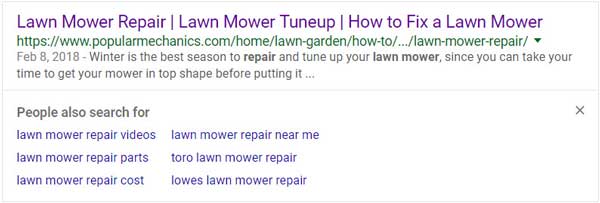
This is Google’s attempt to salvage a failed search. They know that if you can’t find the content you need to solve your task, you might not choose Google the next time you search, which means less revenue from ads and other Google products.
Simply put, it’s in Google’s best interest to make sure that searchers find what they’re looking for, and that means that it’s in Google’s best interest to truly understand a searcher’s intent.
Imagine if Popular Mechanics noticed this pogo-sticking behavior, and decided to build these subtopics into an expanded version of this resource. Recognizing that many searchers needed more than just a general preventative maintenance guide, they could use their resource to guide readers to instructional videos, stats about the most common repair costs, and some guidance on when it’s best to try to do a repair on your own, and when it makes more sense to go hire a pro.
To further establish their site as the go-to guide for lawn mower repair education, they could develop an editorial calendar of content that offers a deeper dive into specific repairs, common models, and advanced tips and tricks that appeal to more targeted audiences.
Their main lawn mower repair guide could link to these resources, creating a single destination that a search engine could begin with in order to discover these resources and understand their relationship to the core topic. Each individual article could link back to the primary guide, elevating the authority of the parent topic and further strengthening the relationship between content.
In short, they would transform their article into a pillar page.
The result of this would be a more useful resource for readers, an improved navigational experience, and the likelihood that they would solidify their top ranking for “lawn mower repair” while capturing hundreds, if not thousands of additional keywords with the same resource.
The Emergence of 10X Content and a Shift towards Topics over Keywords
In the scenario above, I outlined the perfect opportunity for Popular Mechanics to convert an average blog post into a Pillar Page—an authoritative, long-form piece of content on your website that addresses a topic comprehensively in an organized, logical way. It’s something that searchers want, and something that search engines want to serve up in results.
But what has caused this shift towards pillar page when, in the past, simple blog posts may have done the job well enough?
There are a number of reasons for this change, which we’ll touch on briefly here.
1. The way people search is changing.
In the past, if a marketer wanted their content to rank for a specific search term or query, they simply needed to create a piece of content that was tailored specifically to that exact search phrase, and the traffic would pour in. To ensure relevancy to the searcher’s query, the marketer would include the targeted term in the headline, title tag, meta description, their section headers, and their text. And then they’d do it all over again with the next keyword, even if that keyword was close to the first one.
For years, that’s just how marketing worked.
But the way people search has changed drastically in the last few years, especially with the emergence of voice search through devices like Google Home and its competitors. Now, people search a lot more naturally, in the same way that they talk, and this has led to an explosion in keyword variations.

Creating content according to the old playbook would mean writing a new piece of content for each of those variations—a herculean task if ever there was one, for both the marketers (who have to create the content) and the search engines (who have to crawl and understand this content). By shifting the focus from one of “keywords” to one of “topics,” search engines have simplified their job and the job of marketers.
Instead of writing countless articles to cover all angles of a complex topic, a single, authoritative piece of content would now suffice.
Enter the age of pillar pages, also known as 10X, Flagship, and Cornerstone content.
2. The internet is full of garbage.
Another factor leading to the emergence of pillar pages? Well, the internet is, frankly, full of garbage.
When you force marketers to churn out multiple blog posts a week, each targeting different keyword variations, you’re bound to find a lot of repetition and fluff. After all, there’s only so much that one marketer can write. But when you’re trained to think that frequency is more important than quality, that’s just what is going to happen.
That’s how you end up with stuff like this:

It only makes sense, then, that search engines (and searchers) would seek to find ways of cutting through the noise so that they could become more efficient in finding the answers that they are looking for.
Note: Pillar pages of different sorts have existed for nearly as long as the internet. All it took was this overcrowding to really make the need for them obvious.
If you spend enough time wallowing through the muck of a swamp trying to find the road, you eventually come to appreciate the value of an accurate map.
3. Marketers are competitive.
And then, of course, is the fact that marketers are amongst the most competitive people on the planet. Marketers are constantly trying to think of ways to one-up each other—with the goal, of course, of having their own content served at the top of search results instead of the content of their competitors.
This competition led to the emergence of “10X content” which is, essentially, a strategy of looking to the content that is already ranking well and finding out how you can make it 10 times better. In some cases that may have been achievable simply by adding some visuals, or video, or (especially in the early 2010s) an infographic.
The idea was originally introduced by Rand Fishkin, formerly of MOZ, in an episode of Whiteboard Friday.
Read: Pillar Content vs. Cornerstone Content vs. Flagship Content: What’s the Difference?
In the video, Rand explained that it has become clear that more and more often the best way for you to outperform the existing content is to create a resource that is more authoritative and more complete. So if you want to rank for a specific search query you might, for example, look at the content that is already ranking and ask yourself: How can I cover this topic better? What questions might a searcher be asking that this content doesn’t answer? Does this content speak to the searcher’s intent?
This idea was further improved upon with Brian Dean’s “Skyscraper Technique,” which outlined a powerful way to use 10X content as a means to earn high-quality, authoritative backlinks by creating content that blows the competition out of the water.
Then, at INBOUND 2016, Matthew Barby from HubSpot illustrated how he and HubSpot’s SEO team had partnered with their blog’s editorial team to create clusters of content that helped to establish HubSpot as an authority on a number of different topics, and how this topical authority lead to an enormous growth in organic rankings and traffic.
It was in this presentation that the HubSpot team introduced us to the concept of topic clusters and pillar pages.
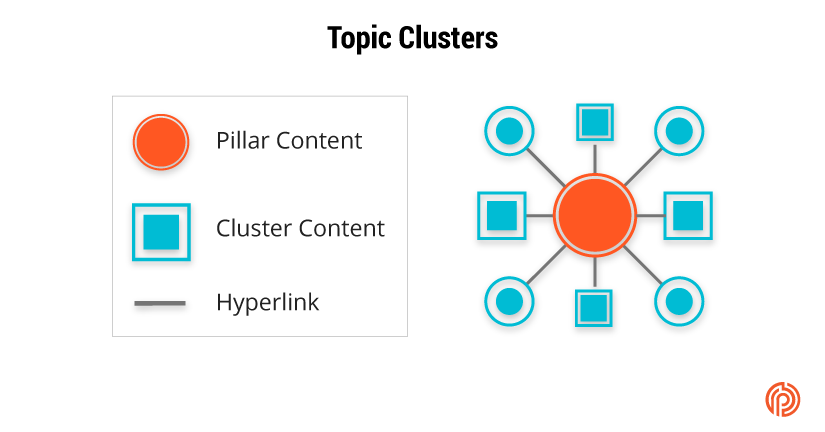
What is a Topic Cluster?
A topic cluster is a selection of related content that is grouped together with hyperlinks to establish a relationship between the content for both search engines and website visitors. At the center of the cluster is a page that provides a broad overview of the main topic, known as a “pillar page.” This interlinking structure helps to improve visibility in search results and to establish topical authority for a brand.
What is a Pillar Page?
A pillar page covers all aspects of a heavily-searched topic on a single page and acts as the center of a topic cluster. Pillar page content creates a path for visitors to explore a topic in more depth by hyperlinking to more detailed blog posts. These blog posts also link back to the pillar page, establishing a relationship between the resources.
The Topic Cluster/Pillar Page methodology has quickly been adopted by the world’s most advanced content marketers and SEOs and has given hundreds of businesses the opportunity to rank for heavily searched, competitive terms that had previously been out of reach.
So where should you begin?
Step 2: Pick a Topic for Your Pillar Page
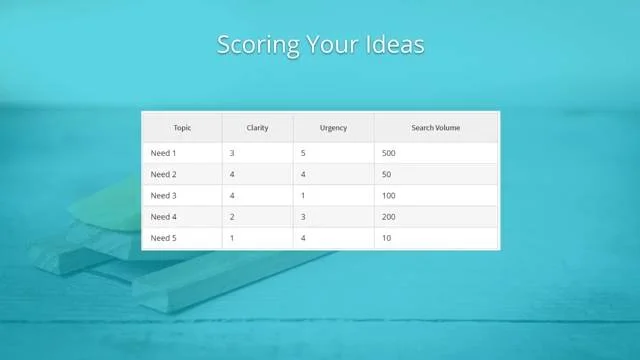
Choosing a topic for your pillar page, ebook, or next marketing campaign is step #1 in the content creation process, and often the most challenging and debated step.
And for good reason.
The creation of these assets will take a lot of time, money, and effort. The initiative will likely take you away from focusing on other potentially valuable projects—that website redesign project you’ve been meaning to tackle, a historical blog optimization effort, or perhaps an overhaul of your email lead nurturing campaigns.
You likely have hefty goals behind this too. Pillar pages are often created when a company needs to build a significant amount of organic traffic to its blog or website. This means that your boss expects your pillar page is going to attract visitors, leads, and links. Lots of them.
What if you spend a full month creating the pillar page only to discover that nobody cares about it? What if it doesn’t rank? What if you don’t see a rise in traffic? Or, just as bad, you see a rise in the wrong kind of traffic?
Those negative outcomes are a painful possibility, but fortunately there are some steps you can take to significantly reduce that risk.
Below is a process that will help you and your organization pick a topic for your pillar page that will grow traffic to your site, and most importantly, resonate with your buyers.
1. Choose the Buyer Persona that you should target first.
The #1 reason that pillar pages fail is that they focus on a topic that the business wants to talk about rather than a topic that a specific type of buyer needs to learn about.
So first things first: When you begin thinking about a pillar page you need to remember that this is about them, not you.
Now that we have that out of the way, let’s think about which of your buyers you should focus on first.
Ask yourself: Which of your personas does your sales team have the most success with? Which segment represents the greatest potential in your plans for growth? Which personas have historically converted from MQL to Opportunity to Customer at the highest rate?
If you focus on the persona that your organization is most likely to win as a customer, you’ll increase the chances that your pillar page effort provides a positive ROI.
It’s also helpful to identify what type of buyer that persona is. Are they more strategic, or tactical? What type of information do they typically look for as they research solutions and make decisions?
Pillar pages tend to be a great fit for more tactical buyers, who need in-depth guides that help them think through a topic comprehensively. (Check out these examples if you need some inspiration.)
On the other hand, if you’re targeting a busy executive who is mostly focused on big-picture strategy, a 2,000-15,000 word resource might not be the best way to go. They simply won’t have the time, attention, or energy to dedicate to consuming content that is that long.
Sometimes, you may choose to pursue a persona that is NOT your typical buyer. This approach may make sense when you see your pillar page as more of a PR or link-building opportunity than a direct lead-generating opportunity. If this sounds like you, put extra emphasis on Step #6 in this list.
2. Brainstorm a list of your buyer’s needs.
At Pepperland, we’re firm believers that for every product, service, or solution, there is a corresponding skill, process, or strategy that your customer needs to obtain in order to find success.
These skills, processes, or strategies align directly to real customer needs that your pillar page should help address.
For example, in order for a working professional to pursue their Master’s Degree while working full time, they’ll need to develop sharp time management skills and a strategy for affording a graduate education.
Another example: In order for a marketer to realize value from their investment in a tool like HubSpot, they’ll need to develop a strong inbound marketing strategy and content creation skills.
Brainstorming these needs can become a little easier with some structure to guide you, which is why we created this campaign topic worksheet.
Use our free, ungated worksheet to capture your ideas.
To keep your ideas framed through the lense of your buyer’s point of view, consider listing each idea as a User Story. This would look something like this:
As a [PERSONA], I need to [GOAL], so that I can [BENEFIT].
Just make sure you don’t make the mistake of generating these ideas without conducting thorough buyer persona research first. You may feel like you know what your customers are thinking, seeing, and doing, but if you’re not working directly with them on a day-to-day basis and haven’t spent a mile walking in their shoes, there’s a good chance you’ll be making some false assumptions. And building a pillar page on false assumptions is a surefire recipe for a failed pillar page.
3. Eliminate any ideas that don’t lead to your solution.
Once you’ve brainstormed the list of needs that your ideal customer is likely facing, you’ll need to remove any of those needs that do not either directly or indirectly lead the customer to your solution.
For example, let’s think back to the working professional who wants to pursue a master’s degree. If they have children, then on top of balancing their career and education, they will also need to develop a plan around childcare. Though this is a clear need of the customer, unless your product or service addresses this directly or indirectly, it is not something that you should focus your efforts on.
By ensuring there is a direct line between the need and your solution, you will see the greatest return on your content marketing investment.
Remember that your goal should be to find a need, problem, or pain that your prospects or customers will need to overcome in order to adopt or find success with your product or solution. The purpose of your pillar page content will be to give them the process, skill, or strategy required to overcome that challenge.
4. Prioritize by urgency, clarity, and level of pain.
With a list of 5-20 needs in mind, it’s time to find the one that your buyer will be the most motivated to fulfill. You are looking for a pain or problem where the cost of inaction—living with the status quo and not making any change—significantly outweighs the cost and effort to solve it.
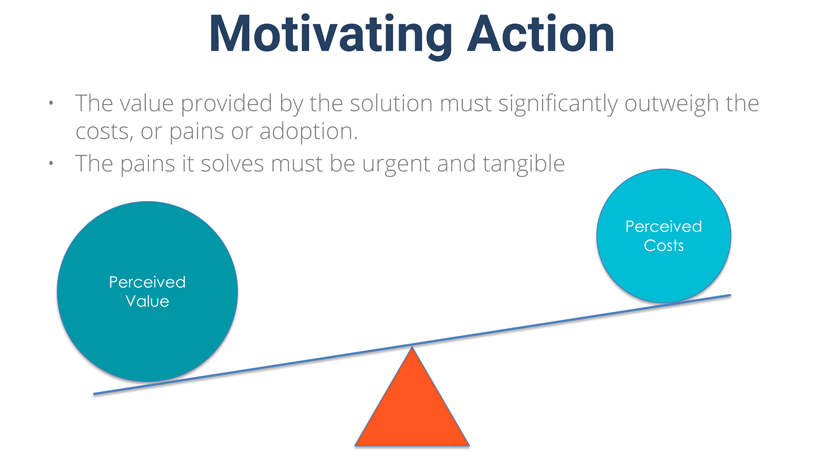
List out all of your ideas as sticky notes on a whiteboard, or in a spreadsheet, and assess their:
- Level of severity: Is this something that someone would lose their job over if it wasn’t solved, or is it more of an annoyance that someone could easily go on living with?
- Clarity: Is this a pain or need that everyone is aware of and regularly discussed? Or is it more like the leak behind the wall that you don’t know about until it’s too late?
- Monthly Search Volume: Is anyone searching for this topic on Google? You’ll need a keyword tool like Moz Keyword Explorer or Ubersuggest for this.
Start by listing out each idea, and then scoring them by severity and clarity on a scale of 1-5. Layer in the max monthly search volume pulled from your keyword research tool.
| Topic | Clarity | Urgency | Search Volume |
|---|---|---|---|
| Need 1 | 3 | 5 | 500 |
| Need 2 | 4 | 4 | 50 |
| Need 3 | 4 | 1 | 100 |
| Need 4 | 2 | 3 | 200 |
| Need 5 | 1 | 4 | 10 |
Next, map each rated idea in a bubble chart or in a simple 4 quadrant grid. We’re looking for the topics in the upper right-hand corner, as these show both high urgency and high clarity. They should also (ideally) reflect a higher search volume.
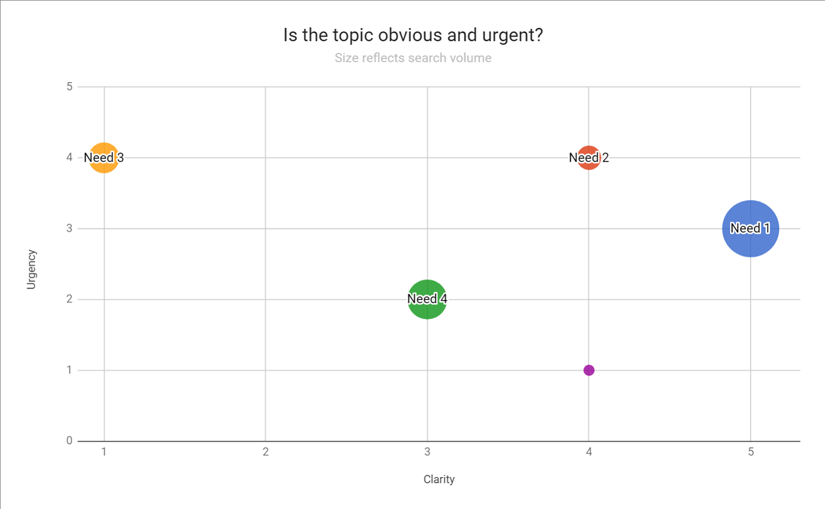
5. Look for an unmet or underserved need.
With a topic or two now in mind that you know your audience will be motivated to seek out, you’ll want to make sure that there is still an opportunity for you to be the one to solve it.
You want to avoid being one of 1,000 solutions to the problem, as it will be extremely difficult to compete and you’ll most likely be too late to the party.
Try doing a quick Google search for your topic and evaluate the results.
I tried this exercise prior to writing this blog, searching “how to pick a topic for a pillar page” in Google. You can see the results below. There was plenty of content that answered the question, “what is a pillar page?” but not a single article that addressed the topic I was searching for head-on. This is an example of an unmet or underserved need, which presented an opportunity for me to the first to fulfill.
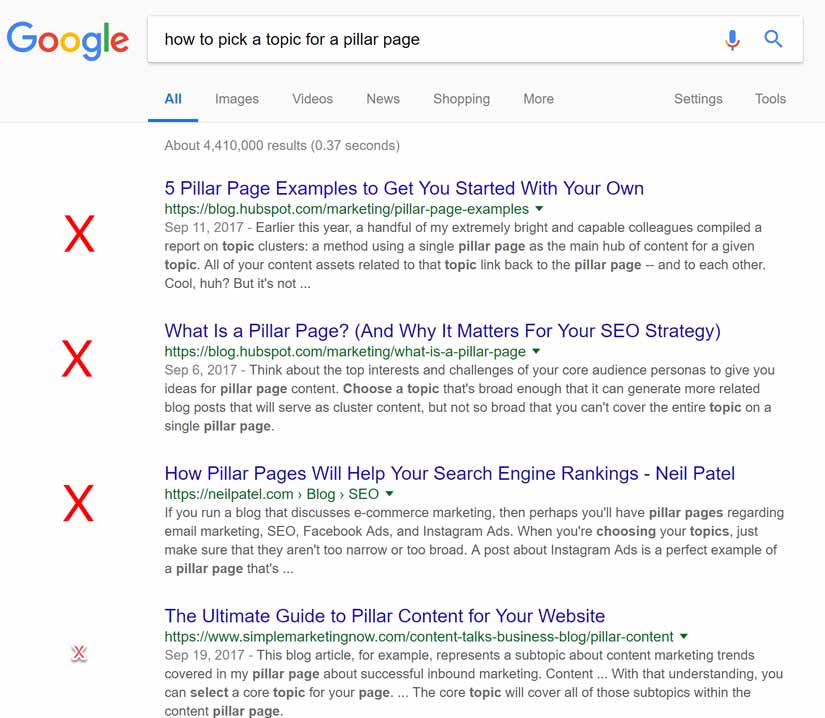
If you find that there are many other sites already addressing the topic, try assessing the quality of that content. Do they serve the searcher’s needs well? Do you see an opportunity to answer the need in a much more effective, or otherwise better, way? This could mean going into more depth, addressing the topic with more clarity, including visual aids, or some other means of making your content more useful to your targeted audience.
If you don’t see an opportunity to be the first to meet the need, or a way to meet that need in a significantly better way than the competition, you may want to consider a different topic.
Note: If you have an extremely authoritive domain (with a Moz domain score of at least 60) the chances of you ranking for highly-competitive terms increases significantly. In these cases, you may choose to create a pillar page for a topic that already has competition. That said, for most websites and businesses, it would be wiser to pursue topics that have not already been thoroughly covered by other sources.
6. Ask yourself: Is this topic linkable? Is this topic shareable? Who would help me promote it?
Creating content that answers the searcher’s intent, serves your targeted audience well, and helps them achieve their goals is essential if you want your content to rank well in search results and grow traffic. But it’s not the only thing that you need to do in order to be successful.
Google and other search engines also evaluate the number of other websites that link to your content as a sign of its trustworthiness and authority. This means that your pillar page must be able to secure external links if you wish for it to rank well in search results.
A quick test of the linkability of your topic is to try the “inurl:” search operator plus the word “links.html” and your topic in quotes.

This will return a list of sites that curate lists of valuable links on a given topic. If you find hundreds of results, chances are that you have a very linkable topic.
To find out if the topic is social-friendly and likely to be shared, try searching for your topic in a tool like BuzzSumo. Look for topics with dozens, or ideally hundreds, of results.

If you’ve found a topic that you feel is either linkable or shareable (ideally both), you’ll want to test your assumptions by beginning to build a real list of bloggers, influencers, journalists, and people within your network who you believe would help share your content once you’ve created it.
Try brainstorming an actual pitch to these people. What’s in it for them to share or link to your content? Is your pitch compelling?
7. When unsure, test it first.
If you’ve read this far, you’re likely now thinking “wow, this is going to be a TON of work.” You’re likely having some doubts that the effort will be worth it, and perhaps the risk of investing all this time, money and effort into a pillar page that may or may not be successful is a bit too risky.
Executed well, pillar pages are one of the most effective tactics out there for ranking highly in search results for heavily searched, highly competitive terms—but there certainly is some risk.
If you’re a little bit too uneasy about going all in on a pillar page, you can test the viability of the topic by starting with a high-quality, long-form blog post first. Make sure the article is good enough to have a decent shot at ranking highly in search results, and then watch the data start to come in.
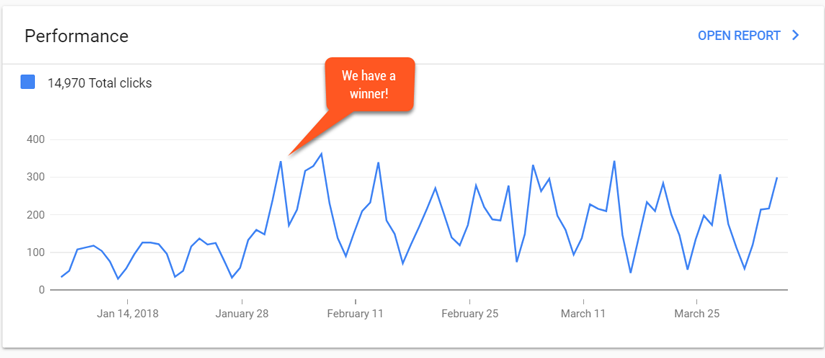
If you see the article start to climb towards the top ten and begin to rank for dozens, or even hundreds, of terms, there’s a good chance that you’ve found a good opportunity. You can now invest the additional time to cover the topic with more depth and invest in the custom graphics, videos, or other elements that you skipped over initially.
What comes after you’ve identified your topic? Actually writing your content! But before you dive in creating something new, you should conduct a quick audit of your existing content to see what you might already have in place.
Step 3: Map Your Existing Content into Topic Clusters
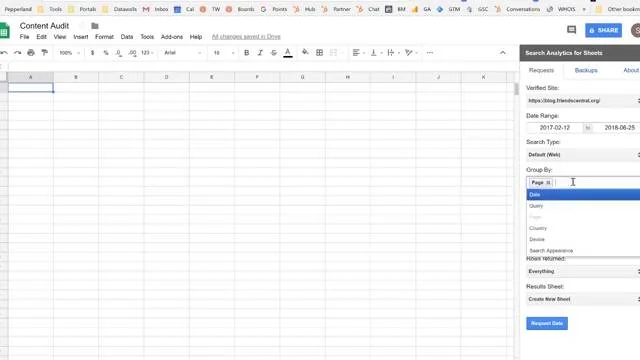
When you first decide that you want to incorporate pillar pages and topic clusters into your company’s marketing strategy, it’s easy to feel overwhelmed.
Though there is no hard-and-set rule about how many words a pillar page needs to be, they do need to comprehensively address a topic. By this very nature, they will tend to skew towards the longer end of the word-count spectrum. In fact, most pillar pages will fall somewhere between 3,000 and 5,000 words. Some can be even longer—10,000 to 20,000 words or more.
While this is undoubtedly a big undertaking, there’s some good news for those of us who have already been creating content for months or years: You can use that existing content!
As we discussed above, a pillar page is a piece of content which thoroughly examines a particular topic or idea. This pillar page is the central support for your topic cluster, which consists of 8-12 blog posts that dive even deeper into various aspects of your pillar. Ultimately, this means that for your pillar page to be successful, you must create:
- 1 pillar page
- 8-12 supporting blog posts
- Ancillary materials (visuals, charts, downloadable materials) in support of both the pillar and individual blog posts
But if you’ve already been creating content as a part of your marketing efforts, you’ve likely got a fair amount of this work already done. For example:
- You may have recently published an ebook which, with a little fine-tuning, can be reverse-engineered into a pillar page (or at least act as the bedrock of your pillar page).
- If you’ve been blogging religiously for a few months, there’s a good chance that you’ve got blog posts that can form the beginning of a topic cluster.
- If you’ve been at it even longer, you may already have the entire topic cluster built out in existing blog posts, leaving you with just the pillar to create.
- If you’ve heavily pursued social or email marketing, you’ve likely got custom graphics, images, and video that you can leverage in your pillar and supporting blog content
The list goes on.
That’s why, before you begin creating anything, you need to know what you’ve already got. To reach that understanding, you’ll need to audit your content.
How to Audit Your Existing Content
At it’s simplest, a content audit is just a list of all of the content that you’ve published or created. Many businesses might keep track of this in something called a content library, others might use an editorial calendar (or something similar) to catalog their content, and others yet may simply use a spreadsheet.
If you’re already using one of these methods to track your content as you publish it, you likely already have a system in place that allows you to sort by topic. In this case, identifying the content that you’ve already got that can support your pillar should be easy: Just filter the list, find the content that relates, and think about how you can use it to make the process of making your pillar easier.
If you don’t already use one of these systems, you’ll need to start from scratch. Luckily, you can pretty easily leverage Google Search Console to create a list of content on your website and see the keywords and topics that it is already ranking for. You can then use this information to group that content into potential clusters, and from there figure out how you might be able to leverage it.
This is, admittedly, a high-level overview of the process of auditing your data. For a more detailed, step-by-step walkthrough, watch the video above, where Sean shows you how to import Google Search Console data into a Google Sheet and convert it into an easily sortable pivot table.
Taking the time now to understand the content that you have, and how you can use it, may save you days or even weeks of work.
Step 4: Write Your Pillar Page
Once you’ve identified the primary focus of your pillar page, and completed a content audit to determine what content you already have, you can finally begin to create your content. And that means one thing: Copywriting.
Copywriting for The Web
Some people might think that writing for the web is the same as any other kind of writing, but the truth is, it is very different and brings with it its own unique challenges. This primarily stems from what the web is and how people use it, which is very different from how people might use a book (for example).
This means that there are certain best practices that you should always use when you are creating any resource for the web, whether that be a pillar page or a blog post. Here, we’ll discuss some of those more general copywriting best practices that you should incorporate into your content creation in general.
1. Start with a keyword in mind.
This should go without saying, but before you begin creating any content, you should have a keyword or phrase in mind that you want the content to rank for. Even in the case of a pillar page, where you will hopefully rank for hundreds of keyword variations, you should have a specific, high-value keyword in mind before you begin any writing.

Later, when you begin to write your content, you will strategically weave this keyword and its variants into your text.
2. Identify the Searcher’s intent.
If you want to create content that is going to resonate with the reader and perform well in search, then you can’t just create content that you want to create. You need to create the content that your reader wants and needs.
The easiest way to do this is to create a user intent statement which explains why a searcher is conducting a search. Once you understand the intent—the why behind a search—you can create content that effectively addresses it.
This is an example of a user intent statement that we fill out prior to creating any content:
As a (PERSONA), I want (TO LEARN MORE ABOUT X) so that (I CAN ACCOMPLISH Y).
For example: “As a digital marketer, I want to learn more about copywriting techniques for writing pillar pages so that I can effectively create a pillar page that will be valuable to my business.
But you can’t just make assumptions when completing your user intent statement. These statements should be informed and/or validated by conducting persona research that helps you to truly understand the motivations, hopes, and fears of your targeted audience.
3. Structure your content in a user-friendly way.
People don’t often think about text as being something that can be user-friendly. But the truth is, text can be easy to use and consume, or it can be difficult to use or consume. And it’s surprisingly easy to turn content that is difficult to read into content that is easier to read.
By following just a few simple rules, you can dramatically increase the usability of your content, making your readers happier and signaling to Google that your content deserves to be ranked higher:
- Use Subheads to break up your content: Before someone decides to sit down and read through an entire blog post or article, they’ll often do a quick scan to try and determine whether or not they should even bother reading the content. By adding easy to spot subheads (H2s and H3s), you make it easier for the reader to know what your content is about and whether or not it will help them. (These also help Google understand your content, which can help with your rankings.)
- Keep your paragraphs short: Large blocks of text are intimidating for the reader, and can encourage someone to just skim your content instead of fully reading and understanding it. By keeping your paragraphs shorter (three to four reasonable sentences in length) you encourage a deeper reading of your content.
- Use text formatting to your benefit: You can use certain text elements to draw your reader’s eyes to the content that you want them to read. Bullet points, numbered lists, block quotes, colored text, etc., can all help you keep the reader focused and moving through your content effectively.
- Keep accessibility in mind: According to a study conducted by the CDC, an estimated 61 million Americans have a disability of some kind which may impact how they consume information on the web. For that reason, it’s important to make your content as accessible as possible. This means things like using appropriately-sized text and fonts, making sure that there is adequate color contrast between text and other on-page elements, and a whole lot more. Not really content-creation related, but important to keep in mind.
4. Write naturally.
When internet search was in its infancy, in order to find the information they were looking for, searchers needed to structure their searches in a particular way. But search algorithms have become so much more advanced in the decades since that the way that we search has dramatically changed. Simply put, we can now ask a question using incredibly natural language and syntax, and the search engines can now infer what we mean.
And that’s a good thing. In the past, getting found in search often meant writing in a way that the search engine would understand. Though good for search engines, this often meant writing in unnatural ways which could be difficult for a reader to consume.
Now that the search engines can understand more natural language, that means we can write naturally (good for the searcher) without damaging our SEO efforts. In fact, trying to create content according to the old rules of SEO will now actually damage your rankings and SEO efforts.
Simply put, human beings and search engines both want your content to be written in natural language. More often than not, that means writing the way that we speak, and doing your best to avoid writing content that is difficult to understand.
Not sure if your content sounds “natural”? You could use a tool like the Hemmingway App, which grades the readability of your text.
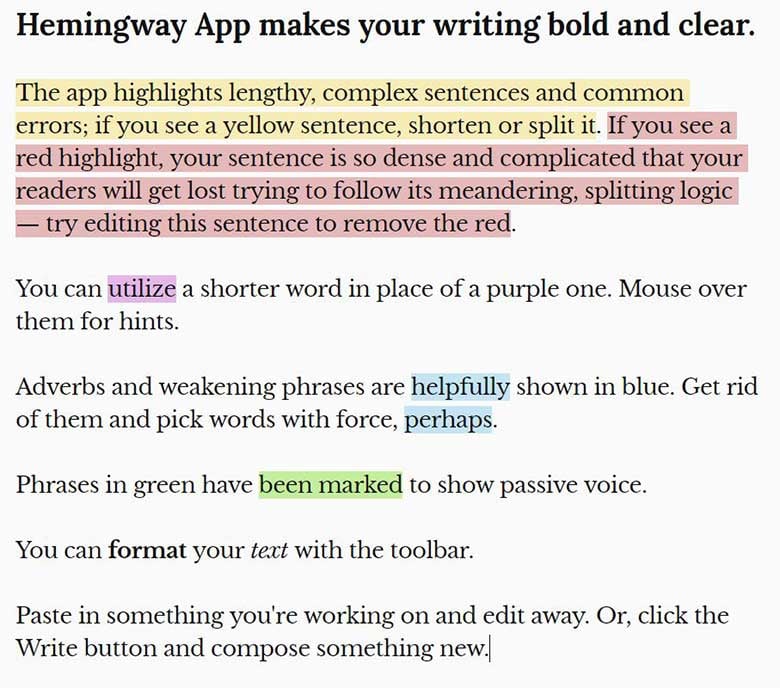
Or you could opt to use a tool like Google’s Natural Language Processing API, which analyzes your text and interprets it based on a number of factors.
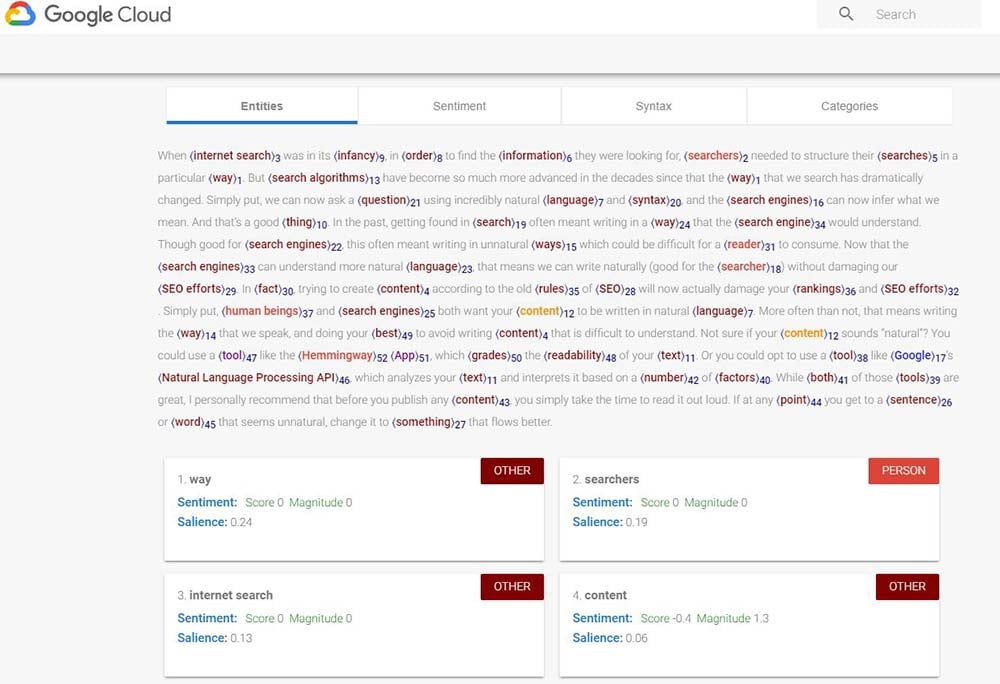
While both of those tools are great, I personally recommend that before you publish any content, you simply take the time to read it out loud. If at any point you get to a sentence or word that seems unnatural, change it to something that flows better.
5. Edit for grammar and spelling errors.
Once you’ve written your comment, it’s incredibly important that you go back and edit the content for spelling and grammar mistakes, for a number of reasons.
For starters, when a visitor lands on content that you have created, they do so understanding that you are an expert on that content. But every time the reader encounters a spelling or grammar mistake, that trust in your expertise gets damaged. One or two errors in a blog post might be forgivable, but a piece of content rife with errors is definitely going to raise some red flags in whoever is reading it.
Beyond this, the quality of your content (and how many errors your content has) will definitely have an impact on your SEO efforts and your ability to rank. This may be a direct impact by Google penalizing you for errors, or it may be an indirect impact caused by, for example, other websites refusing to link to you because they don’t want to link to sites that are full of errors.
Luckily, there are a number of tools that you can use to make your writing cleaner. One of our favorites is the free Grammarly Chrome extension, which instantly marks errors while you type.
6. Read for consistency and clarity.
Beyond editing for obvious errors, it’s also important to look at your content through a lens of consistency and clarity.
How easy is it for the reader to follow along with your content from start to finish? Is there a clear path from point A to point B, or does the water get a bit murky? Do you consistently use the same words and phrases when talking about a topic, or do you bound back and forth between multiple different phrases?
Why is this so important? Because it speaks to user experience. If your content is clear and easy to understand, the reader is more likely to get value out of it. This makes them more likely to share your content through social media and to link to it from their own website, both of which can help your SEO efforts. If, on the other hand, your content is confusing to read or difficult to follow, the reader is going to leave your website and find a different resource to leverage.
This is especially important for longer pieces of content, like pillar pages, which can easily lose focus and become diluted if the writer isn’t careful. For that reason, I typically recommend that someone besides the writer read through the content and flag any areas that are difficult to read.
But beyond simply being consistent throughout a single piece, you must make sure that your content is also consistent across multiple pieces of content. The easiest way to do this is to create a set of clear editorial guidelines and a brand voice that your writers will be able to leverage as they create content.
7. Think about what other questions your reader might have.
As your reader reads through your pillar page, they are bound to have a lot of questions. Whenever possible, you should do your best to try and think of what those questions are, so you can preemptively write about them.
By doing so, you can make your pillar page even more authoritative and complete, making it more valuable for your reader (and, therefore, more likely to appear in search results).
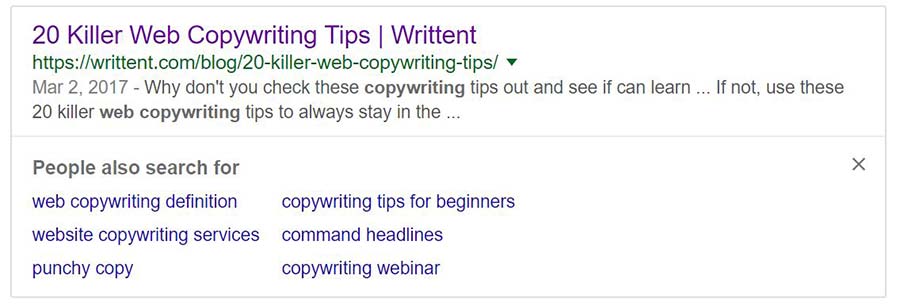
One way that you can do this is by leveraging the “People also search for” function in Google. This is a little window that typically pops up in Google results when someone first clicks on a search result but then hits the back button, and it is pulled from past searcher behavior. It can be incredibly helpful in identifying the questions that your content should address, and can even be helpful in building out your topic clusters.
Copywriting for Pillar Pages
Writing a pillar page is, in many regards, very similar to writing any kind of content for the web, so you’ll want to keep in mind everything that we mention above while you’re writing your pillar page and topic cluster. But pillar page creation also comes with its own unique challenges.
The primary challenge? Ensuring that the narrative of your pillar page is strong enough to carry all the way through what will, ultimately, be a very long document.
This can be hard enough with shorter works, but for pillar pages it is essential: If you don’t have a strong narrative, then your reader is going to lose interest. And if they lose interest, then your pillar page isn’t able to accomplish what you need it to accomplish.
So how can you combat this? Unfortunately, there’s no silver bullet, other than to make sure that you’re aware of the concern. As you write each section of text (and, especially, as you edit it) make sure that you can clearly connect back to the narrative.
One potential strategy to keep the narrative consistent: Sit down and write your pillar page over the course of a single day or week.
This obviously isn’t always possible. But when it is possible, completing the first draft of your pillar page in one go can help you keep the narrative center-stage in a way that can be challenging when you are piecing the resource together over a number of weeks or months.
Step 5: Design Your Pillar Page

When it comes to creating any kind of web content, design is important. But it’s especially important when you’re talking about an important piece of content like a pillar page.
Simply put, your pillar page design should:
- Encourage readers to stick around once they’ve landed on your page. Pillar pages are massive pieces of content, which can be incredibly intimidating for a reader to land on. A well-designed pillar will make it easy for the viewer to digest all of the content on the page and encourage them to stick around.
- Encourage readers to share your content, whether on social media or by linking to it from their own websites. While the content itself will, of course, play a role in this, the importance of design is hard to overstate: People like to share stuff that looks cool.
- Convert. Ultimately, the goal of creating your pillar page is to attract viewers to your website and to get them to convert into leads. Your design should facilitate this.
So, how can you design a pillar page that achieves all of these goals?
Unfortunately, there’s no hard-set formula for what every single pillar page should look like. That would be too easy (and boring!). But there is a relatively easy process for determining what your pillar page needs to look like.
How to Conceptualize Your Pillar Page Design
For your pillar page to be successful, it needs to do a couple of things. Perhaps most importantly, it needs to rank well (hopefully first) in organic search. That is what is going to get it in front of the people who will share it, link to it, and, ultimately, become your leads.
But that’s easier said than done, especially when you are talking about a highly competitive keyword like the ones that pillar pages typically target. How can you create a piece of content that will unseat whatever content is already at the top of search results?
The first step is to understand the content that is currently ranking.
Do a Google search for the keyword that you want your pillar to rank for, and open all of the results on the first page. Then, conduct an audit of each page:
- What does the content look like, both in terms of text and design?
- What elements do they include?
- What elements do they not include, which you could include in your resource to differentiate your content and “one-up” what exists?
Once you’ve done that, look at each page again, through the eyes of the persona that you are targeting. When a person does a Google search, they are doing so in order to reach a specific goal. We call this user intent.
- Does the content that is currently ranking fulfill the user intent?
- Does the design facilitate easy use?
- Does the content lack anything that the user would expect to find?
These insights should inform your overall pillar design. They’ll also help you to get a sense of what kind of design budget you might need for the project. If all of the currently-ranking content is poorly designed (or not really designed at all) then you probably don’t need to put in too much effort or money creating a better design. If what is already out there is very highly-designed, though, you’ll likely need a budget that allows you to compete with that level.
Common Design Elements of Pillar Pages
All of that being said, there are some common elements that all high-quality pillar pages should include, and for a very important reason: They make using your resource easier (and just plain better) for your reader.
So, as you are designing your pillar page, keep these best practices in mind.
1. Sticky Navigation
Sticky navigation is incredibly important for pillar pages and other forms of lengthy content, because they make it easier for your reader to use your resource. It allows the reader to jump to the exact section of your page that answers their question, and from there, it allows them to jump around to other sections.
What do we mean by sticky navigation? Essentially, this is a design element that acts almost like a table of contents. Except when the reader scrolls down, the navigation stays with them—it sticks, either to the top of the window or, sometimes, along the sidebar.
For example, HubSpot created this resource about Artificial Intelligence, which includes sticky navigation at the top of the screen:

Help Scout, on the other hand, includes a clickable, drop-down table of contents that sticks to the top of the webpage:
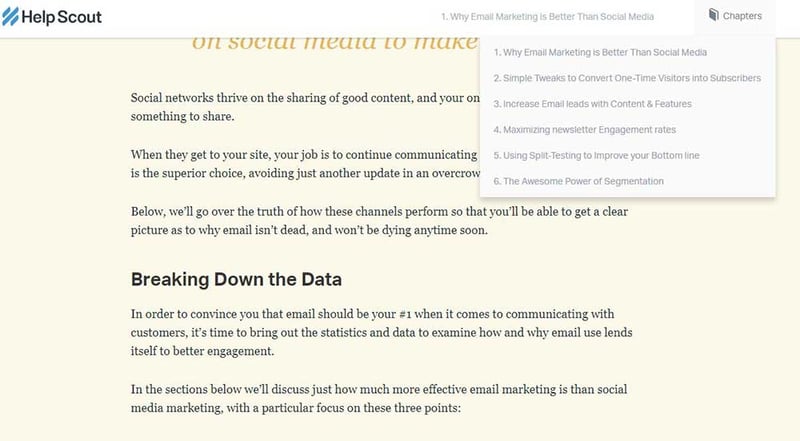
And Typeform includes sticky navigation that clings to the side of the page:
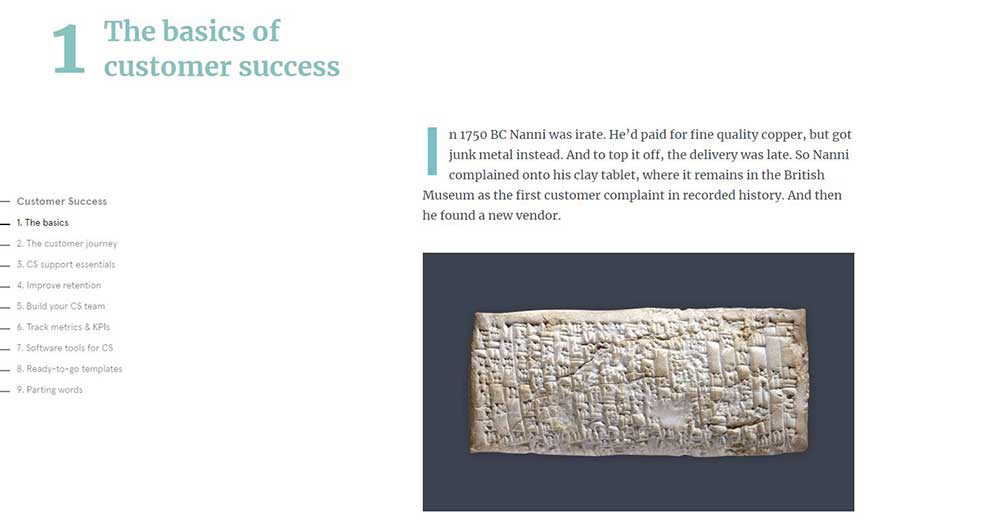
Are any of these formats better than the other? Not necessarily. That will, ultimately, depend on your brand and your customer. If you’re unsure, don’t be afraid to run some testing to see which your users prefer!
2. Scroll Progress Indicator
Scroll progress indicators are also extremely helpful to your user, as they help the reader understand how much more content there is on the page. This design element works (typically) by appearing as a colored bar at the top of the page. As the reader scrolls down the page, the bar fills in more and more, until becoming full at the end of the document.
Looking again at Typeform, we see the scroll bar indicator as the blue bar at the top of the screen, showing the reader that they are about four-fifths of the way through the page.
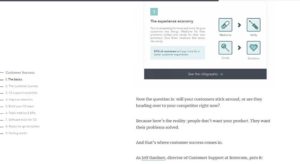
Why do website users like this? Well, as with sticky navigation, the scroll bar indicator helps the reader orient themselves within your resource, something that is incredibly important in a large document like a typical pillar page. It also makes it easy for the reader to know how much more there is to a document, which can be helpful if they are short on time.
3. Images and Graphics
This should go without saying, because it’s generally important for all web content, but I’m going to say it anyway: You need to use images and graphics to break up the text on your pillar page. This helps make the content more easily digestible, prevents the reader from being scared away or intimidated, and helps you to rank in Google Image Search (which, again, can help you acquire links).
Plus, images can make communicating a complicated subject or concept a lot easier. If you find yourself struggling to communicate something with words, ask yourself if a graphic (whether a photo, illustration, graph, or chart) can help.
4. Easily Shareable Content
Similarly, if you want people to share your content, your design needs to help facilitate that. This means that your design, broadly, needs to be aesthetically appealing. But you can also facilitate social sharing and linking by including easily shareable content.
What do we mean by that? Simply put, we mean you should include content that people want to share. Interesting statistics, cool images, pull quotes, etc. can all help you a.) pull the reader to the information that you want them to focus on, and b.) encourage them to share.
Here’s a great example of a pull-quote in action:
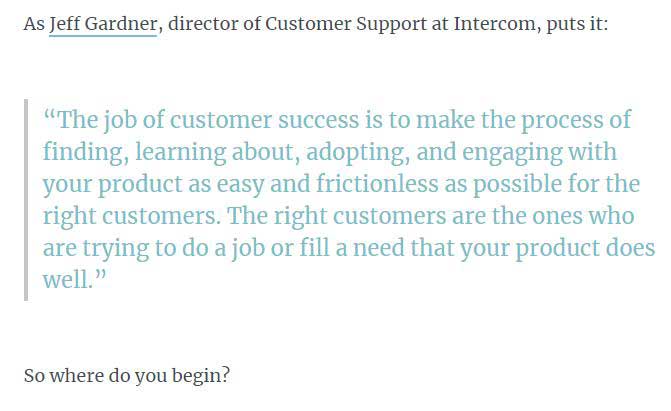
And here’s a great custom image that explains how different pieces of a marketing strategy fit together:
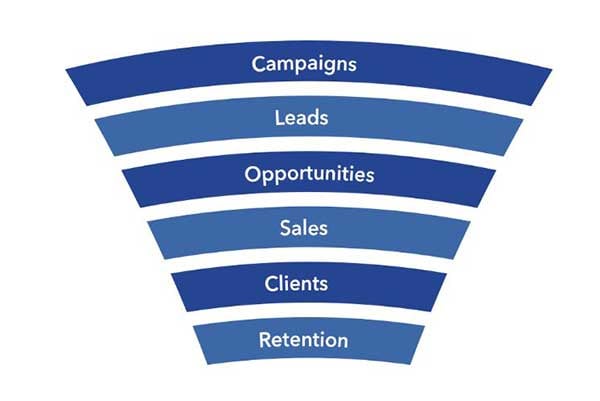
5. Smart Use of CTAs
You want your pillar page to rank well in search so that it brings visitors to your website. But you also want your pillar page to convert those website visitors into leads that you can target in your marketing efforts. For that reason, it’s really important that you use CTAs throughout your pillar.
Ideally, you’ll use a number of CTAs. First and foremost, you should offer the pillar page itself as a downloadable PDF or guide, because a lot of people will either want to save it or print it out (especially older folks who prefer hard copy).
Beyond this, you may want to weave in CTAs to additional supporting content offers (templates, checklists, etc.) that would be beneficial and helpful to your reader.
For example, SaaS DNA Project includes a sticky CTA that stays along the sidebar of their pillar page when the user scrolls, encouraging the reader to download the guide:
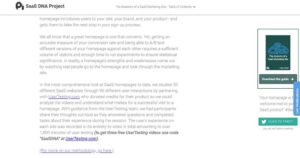
And Gather Content puts theirs right at the top of the page (although it is a little light on color—they might have more success with a more eye-catching button):

6. Basics of Design
And of course, if you’re ever in doubt, you can rest easy knowing that if you follow the basics of good design, you will create a resource that is enjoyable to use. Some basic design principles you should be sure to follow:
- Use white space to your benefit
- Make sure your font and text are large (and clear) enough to read
- Use colors that complement your brand but that also work well with each other
- Use images to break up text without making the page look disjointed or busy
Keeping the User In Mind
Ultimately, for your pillar page design to do what you need it to, you must keep the user in mind. What does the user expect to find? How would they expect your resource to work? What can you do to make the user happy and encourage them to share and link to your resource?
Step 6: Promote Your Pillar Page

As you can see, creating a pillar page takes a lot. A lot of time, a lot of work, a lot of focus and effort, and even, potentially, a lot of money (especially if you need to hire a designer or developer in order to make truly valuable content.
If you’re going to devote all of those resources to creating a pillar page, then it’s essential that the page ends up being a success. Otherwise, you’ll just have created a comprehensive guide that no one will read and that has no impact on your business. And that would be the very definition of the word wasteful.
But how can you make sure that your pillar page doesn’t flop?
The largest determining factor of success is, of course, going to be the pillar page itself:
- Did you target the right keyword and topic?
- Did you devote enough time to understand what the searcher is looking to gain when they perform a search for that topic?
- Did you follow the best practices for copywriting and design when creating the page?
These factors are all going to determine how well the page performs in organic search. But as anyone who works in content marketing can tell you, it takes time for organic traffic to pick up.
Google takes a number of factors into consideration when determining what content to rank at the top of search results, and one of the most important is the number of outside websites which are linking to your site as a resource, which Google uses as a signal of authority. But it takes some time to start getting those links.
So how can you give your pillar a boost to ensure that it begins driving traffic to your website, while you wait for the Inbound Engine to kick into gear? One word: Promotion.
As a wise and anonymous man once said: “Content marketing is one part creation, and nine parts promotion.”
There are certain actions that you should always take every single time that you create any content, and you should, of course, follow steps to get your Pillar out to the public. These include:
- Promoting your content through your social channels
- Devote a portion of your ad spend for social and PPC to the content
- Send the content to your database of leads and evangelists through email
Every piece of content you publish should get this level of support at a minimum to ensure that it begins getting traffic, accruing links, and ranking well in search. But when it comes to pillar pages, which entail so much more work, effort, and resources, you should be doing a lot more in order to give the content the jolt that it needs to perform.
Below are some content promotion strategies that should consider for your Pillar.
1. Ask influencers to help you create the content.
Involving influencers as you create your content is great. As a strategy, it gives you quotes and resources (for example, data) to use in your content, adding heft and credibility that will help you become more trustworthy to the searcher and search engine.
It also lets you build an amplification network right into your pillar page. Once your Pillar is live, with the contributions of the influencers, you should notify them by email and through social, encouraging them to share within their own networks and to link to it from their own websites.
What kind of influencers you decide to include will, of course, depend on your business and industry, but some great ones to consider are:
- Professional associations
- Industry experts
- Influential authors or books, blogs, and websites
- Social media influencers
2. Host an informal Facebook Live Q&A.
Facebook Live is a great way to drum up interest in your pillar page through social media, particularly if you have a large social following or if the topic of your Pillar has a broad appeal.
Use your Q&A to introduce the world to your pillar, let people ask questions, and do your best to answer them. This will help you position your Pillar as THE resource that people should turn to solve their particular problem, which will be essential in attracting links, and can also help you uncover additional questions or topics that you can weave into your pillar page and topic cluster to make it even more definitive
3. Embrace YouTube.
When most people think about getting their content to rank, they instinctively think about Google, which makes sense: It is the world’s largest search engine, after all. But focusing purely on Google means missing out on the second-largest search engine: YouTube.
By repackaging your content in video format, you can get it in front of those searchers who turn to YouTube first, instantly increasing your content’s reach and attract visitors. Plus, you then have a video that you can weave into your social promotion strategy and the content itself, boosting your ability to rank.
The key to success is ensuring that watchers have a path back to your website. YouTube makes this relatively easy to do with its video overlay features, but you should also be sure to include a link to your content in the description of your video so that interested viewers can click through and learn more.
4. Turn to Quora and other related forums.
Sometimes, when a person is looking for an answer to a problem or question, they don’t want to rely on a search engine for an answer. Instead, they may decide to turn to a forum like Quora or Reddit (or an industry-specific forum) that they trust, where they can essentially crowdsource a solution.
These people are often some of the more motivated searchers. Either they’ve tried to do a Google search and been unable to find the solution that they need, or they need a solution so urgently that they wanted to put out a universal call for help.
Either way, these are people that you need to get in front of. In the best case scenario, they may very well be ready to buy; in a second-best case scenario, they may be willing to link to your content and promote you through their own social channels if you are able to help them.
When you publish your pillar page, you should search through Quora and other forums for questions related to your topic, answer the questions honestly in order to help the searcher/asker, and include a link back to your pillar page. (But make sure that you aren’t being overly promotional, because that can backfire severely.)
Other Tactics
The promotional tactics above are some of the ones that we’ve had the most success with when promoting pillar pages for ourselves and our clients. But that doesn’t mean that other content promotion tactics can’t work, or that you shouldn’t try them. Some of our other favorite methods include:
- Becoming a resource for reporters who are likely to link to your content in their assignments (using a tool like HARO)
- Packaging up key “insights” (for example: quotes, data, charts, etc.) in a format that can be easily distributed to a media list
- Repacking pieces of your content as Instagram Stories or Twitter Moments to encourage greater social engagement
- Sharing the content within relevant communities and forums
Step 7: Measure Your Performance
Once you’ve created your pillar page and topic cluster, it’s important that you put a plan in place that will allow you to effectively measure its performance.
Why?
Without an adequate measurement plan in place, it will be nearly impossible to know what the pillar’s ROI was. If you’re going to dedicate the time and resources that it’s going to take to create a pillar page, then you (and the project’s other stakeholders) will want to know how it performs for you.
Analysis is also important in the short term: If your pillar doesn’t seem to be performing well, analysis might offer you insights that you can use to strengthen the content so that performance improves.
Set Goals for Your Pillar
Before you can measure the performance of your pillar, you will need to set some goals for the project. (Ideally, this will have been done before you start creating any of the content.)
So ask yourself: What does the pillar page need to do to be considered successful? Does it need to:
- Generate leads? How many?
- Convert leads into customers? At what rate?
- Attract links to your website? How many?
- All of the above?
- Something else?
Once you know what your pillar needs to do to be considered a success, you can use that information to generate S.M.A.R.T. goals for the project. In addition to setting a clear benchmark for success, this process will inform what data you will need to leverage in the analysis portion.
Leverage Your Tools
There are countless tools that you can use to measure your pillar’s effectiveness as you work towards your goals, and your organization already likely has a technology stack that you’ll be expected to work within. As long as the tool gives you insights to the metrics that you’ve identified above, any tool should work.
That being said, there are three tools that we recommend you use:
- HubSpot Content Strategy
- Google Analytics
- Databox
1. HubSpot Content Strategy
The HubSpot Content Strategy tool was specifically created with the aim of making it as easy as possible for marketers to measure the impact of their pillar pages and topic clusters.
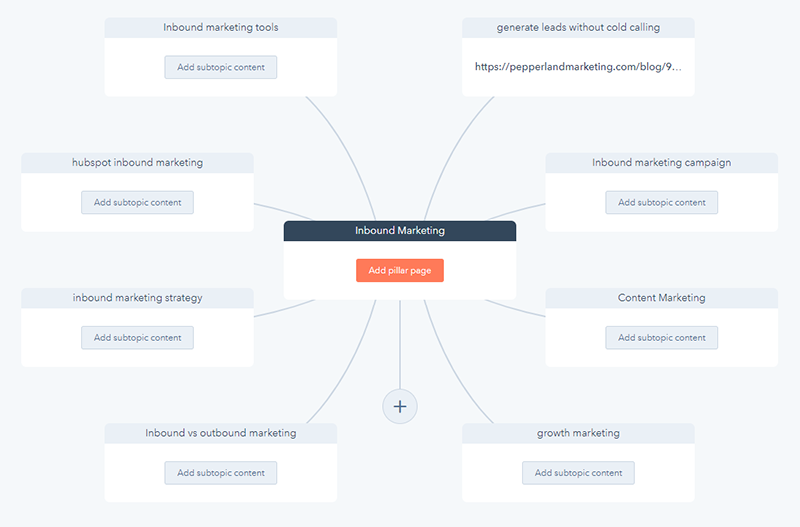
It works like this: At the center of the web sits the central topic that your topic cluster is about. This corresponds to your pillar page. Each of the outer boxes, then, become a sub-topic, which corresponds to the various supplementary blog posts that you create in support of your pillar.
In addition to using the tool to plan your cluster before you go about creating it, the tool also makes it extremely easy to see how the cluster as a whole is performing for you. Just link your content to the tool, and it’ll be possible to see how many sessions the topic cluster has brought you, what the average session duration was, what the bounce rate was, and how many inbound links the content has gathered.
Drilling deeper, you can tie performance back to specific blog posts (or the pillar) and see which content is actually leading to conversions, etc.
2. Google Analytics
Google Analytics is the gold standard when it comes to understanding how your content is performing, and for good reason: The tool gives you access to nearly any metric you could ever need. The most important of these will likely be around the number of users, sessions, and goal completions, but depending on the goals you’ve set for your pillar project, you can likely find much more data.
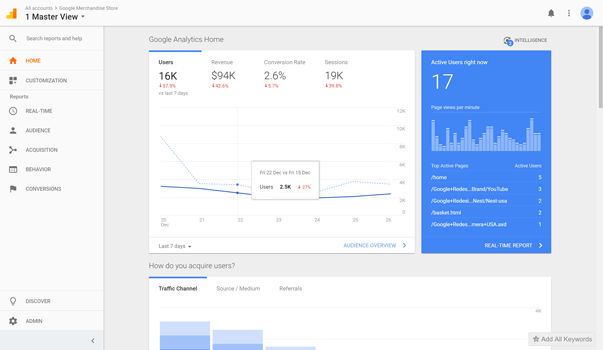
Not a HubSpot user, but still want to track your topic cluster’s performance as a whole? It’s possible to do something very similar to that in Google Analytics, as Sean demonstrates in the video above.
3. Databox
It’s obviously critical that you, as the pillar page’s owner, understand how it is performing over time. But it is also critical that you are able to communicate this information to your team members and the project’s key stakeholders in a way that they can understand.
While some of us might be perfectly content to dive into various analytics tools to view performance data, others might not have the bandwidth or time to do so. That’s why charts and other visual representations of data are so popular and helpful: They allow someone to understand at a moment’s glance what they need to know.
There are all kinds of tools that you can use to create visual dashboards like this, but our personal favorite is Databox, which we use for all of our reporting needs. It’s easy to use, easy to customize, and, best of all, it’s free, making it great for small and big teams alike.
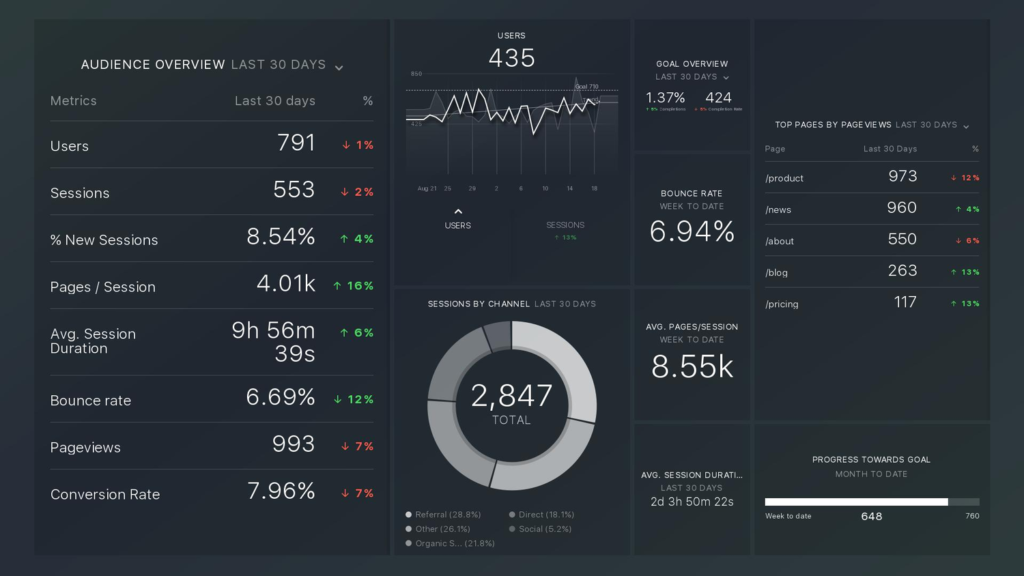
Other Tools
While these are the tools that we personally use and recommend, it’s very possible for you to accomplish all of this using other tools in your stack. Below are some other tools that you might find helpful:
- Google Search Console
- Moz Keyword Explorer
- SEM Rush
- Hotjar
- BuzzSumo
Step 8: Expand Your Topic Clusters with an Ongoing Editorial Strategy
When it comes to pillar pages, businesses tend to follow one of two models. Either they:
- Publish the pillar page and set it free into the wild to do its own thing, checking in on it every so often but otherwise leaving it to succeed (or fail) on its own
- Or they incorporate the pillar page and topic cluster into their broader editorial strategy, where they can continuously add to it as they create additional content that addresses the topic
Of the two strategies, the second one is the one we recommend you follow. You’ve already put in the time and energy into creating the pillar page and topic cluster; why wouldn’t you elaborate upon that bedrock as you continue to grow your content marketing?
Making Topic Clusters the Core of Your Editorial Strategy
Once you’ve decided to incorporate topic clusters and pillar pages into your greater editorial content strategy, it’s pretty simple to augment your existing processes. Below are the big steps that you should take.
1. Download an editorial calendar template.
If you already have an editorial calendar that you use to organize all of your content creation, then you can skip over this step. But if you don’t yet have one, just grab one of the many free templates available online. (We have a pretty great one here.)
This document will essentially act as a home to all of your content marketing needs. It will be where you catalog your ideas, where you plan out your quarterly campaigns, where you track your progress as you create the content, and so much more.
In short, this will be the central hub for all of your marketing efforts. If you don’t already have an editorial calendar, you need to create one.
2. Identify your next topic clusters and schedule as quarterly campaigns.
At this point, you’ve already finished creating your first pillar page and topic cluster. The question then becomes: What comes next.
Ultimately, that will depend on your business. For some hyper-focused businesses, it will make sense to have a just a single pillar page and topic cluster; for others, it might make sense to have anywhere from 2-4 pillar pages and topic clusters.
If your business only needs to pursue one topic cluster, the job here is easy: Just brainstorm quarterly campaigns as you normally would, making sure that the blog posts you pursue tie back directly (or indirectly) to your existing pillar page.
You’ll continue doing this on a quarterly basis until you’ve exhausted all of the possible sub-topics (blog posts) related to your primary topic, at which point it would probably make sense for you to go back and optimize/republish older content.
If your business requires multiple pillar pages and topic clusters, you have a bit more work to do. First, you’ll need to brainstorm all of the pillar pages and topic clusters that make sense for your business to target. Then, you’ll need to prioritize these so that you know which order you will pursue them in.
Once you’ve prioritized the topic clusters you wish to pursue, the one with the greatest priority should become the focus of your next quarterly campaign, with the lower-priority topic clusters forming the base of subsequent campaigns.
After you’ve built out the base of all of your topic clusters, you can then shift gears into strengthening them: Each quarter, return to one of the topic clusters and brainstorm new sub-topics (blogs) that you can write about to more fully explore the parent topic.
In action, this might look something like:
- Y1 Q1: Topic 1
- Y1 Q2: Topic 2
- Y1 Q3: Topic 3
- Y1 Q4: Topic 4
- Y2 Q1: Topic 1
- Y2 Q2: Topic 2
- Y2 Q3: Topic 3
- Y2 Q4: Topic 4
- Etc.
Once you’ve exhausted all of the potential blog posts around each of these topic clusters, it would then likely make sense to go back and begin optimizing/republishing older content.
3. Leverage data to identify new sub-topics.
The process of creating all of this content will of course lead to new insights, which you can use to inform your content strategy on an ongoing basis. What content has worked exceptionally well? What can you do to replicate these successes? What content has failed miserably? What can you do to avoid future failures?
Ready to start building your pillar?
Now that you know what pillar pages and topic clusters are and how you can use them to structure your website and attract more traffic, it’s time to actually put in the work and get it done.
Not sure where to start? We can help you determine the best path forward for your business, whether that is following a pillar page/topic cluster strategy or something else.

